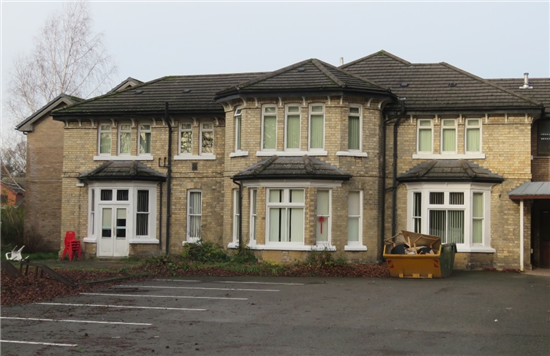When Ruthin Headquartered the County’s Police
Peter Daniels investigates the local knowledge on Heulfre, now part of the Ruthin School campus
Largely hidden behind outlying extensions is Heulfre, once a large proud private residence of manorial proportions. As its size suggests, its early occupants were wealthy and important and included, in 1911, William Robert Evans, solicitor and Clerk of the Peace. In the 1950s, it became a children’s home and, later, county offices and a nursing home but for six all-too-brief years it was the headquarters of the Denbighshire Constabulary.
The reasons why the Denbighshire police force HQ moved from Wrexham to Ruthin are now vague. Perhaps for the same reason that Ruthin was the county town of Old Denbighshire, Ruthin was simply more central. Denbighshire at the time included Llanrwst, Colwyn Bay, Abergele, the Ceiriog Valley and Wrexham. The council’s slightly odd shape filled the convoluted and curious void between earlier established Caernarvonshire (sic) and Flintshire.
The former police HQ was on Wrexham’s Regent Street, where the Wrexham town museum is now. It was in 1961, upon the HQ’s transfer to Ruthin, that Heulfre played host to this important central office. Based at Heulfre were between 40 and 50 staff, some of whom were support staff, usually administrators, but there were other roles, such as storemen and a gardener.
Heulfre had formerly been a Denbighshire County Council children’s home, with a large catchment. Pupils attended Ysgol Brynhyfryd. Heulfre, meanwhile, was owned by Denbighshire County Council.
In 1961, there was initially insufficient space at Heulfre to accommodate all Denbighshire Constabulary’s HQ activities. The central CID was billeted on the second floor at the end of Railway Terrace before later moving to the town police station on Record Street.
It was in 1967 that Denbighshire Constabulary merged with Flintshire’s and the Gwynedd Constabulary. It was at this point the Denbighshire’s final chief constable, Walter Stansfield, retired. The Gwynedd Constabulary itself had existed since 1950, upon the earlier amalgamation of the Anglesey, Caernarfonshire and Meirioneth forces.
The 1967 combined police force was also given the title Gwynedd Constabulary. Obviously, the combined Gwynedd police service did not require three HQs. It adopted as its central location a base in Caernarfon. Interestingly, and no doubt as a nod towards things to come, the police authority was based at Mold, the clerk being Flintshire’s chief executive, T M Haydn Rees.
The 1967 changes were not the end of the matter for Heulfre, though. Heulfre continued in a downgraded capacity but was still one of the most important assets for the new combined police force. From 1967, Heulfre hosted all the enlarged force’s criminal and court records. In the early post-1967 years, these had to be catalogued, assimilated and filed at Ruthin. This, of course, was in the days before there was any comprehension of the computerisation to come, let alone thoughts of a police national computer.
In addition, on behalf of the new Gwynedd Constabulary, Heulfre played host to the central stores, dog handlers’ section and driving academy. The combined police force’s two instructors would teach drivers over a five week period and the novice constables would usually lodge with families in town. New recruits would visit Ruthin to obtain uniforms. Passers by could see dogs trained on the lawn to Heulfre’s front.
More locally, Heulfre continued to house the Denbighshire division’s photographic staff and the Denbighshire division’s operations room, even though the nearest traffic police officers were based at Denbigh. Heulfre offered locally stationed officers at Record Street their night time mess facilities.
It was during the early 1970s that the combined police force considered a new, larger headquarters. During the many meetings, the police authority gave serious consideration to Ruthin as the town to host the new building. It was apparently a close thing but Ruthin lost out.

The black & white photo was taken on the last day that Heulfre was open as a police building, in 1973.
In 1973, Gwynedd Constabulary opened its new centralised headquarters at Colwyn Bay. The functions based at Ruthin at once migrated to the new site. Immediately beforehand, at Heulfre, there were 19 staff remaining, seven of whom were uniformed, the highest ranked being a chief inspector. A year later, to avoid confusion with the new Gwynedd County Council, the Gwynedd Constabulary changed its name to the North Wales Police.
In 1973, Heulfre was surplus to police requirements. In early 1974, after a period of disuse, a small task force of Denbighshire & Flintshire planners commandeered part of the building to thrash out early transport policies for the approaching county of Clwyd. It had not taken long for the building to become slightly dilapidated. It then saw use for education. For some two years, it became the sixth form building and common room for Ysgol Brynhyfryd. Immediately after, it was also refurbished as one of four Clwyd County Council area education offices, which supported local schools and housed peripatetic teachers. As such, it was labelled as County Offices. It never regained its past glory in the public sector but it did play a key role in hosting meetings & discussions which would establish Welsh medium primary education at the new Ysgol Pen Barras. Heulfre closed in the 1980s.
By the early 1980s, it became a nursing home. This coincided with a considerable expansion of the private nursing home sector. In the mid-1980s and again in 1993, the nursing home applied for permission for more extensions. In 1997, Ruthin School acquired the building and converted it into residential accommodation for its boarders.
Heulfre is located off Mold Road, less than a minute’s walk on the left from Ruthin School’s new barrier. Although on a right of way, bear in mind this is still part of a school.
We would like to thank Peter Daniels, the Ruthin and District Civic Association together with Val Roberts, Ron Hughes, Roger Edwards, Pat Astbury, Emrys Wynne, Kay Culhane and Gareth Evans for writing and the information in this article.